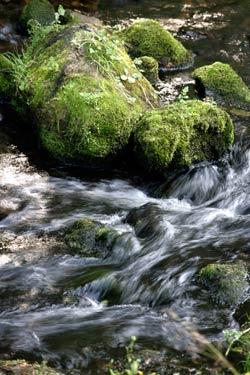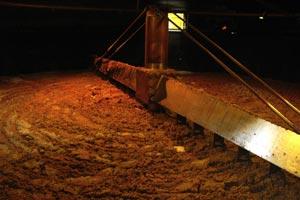WATER AND BREWING

Whether it runs over granite, limestone or quartz, whether it is sourced from churning rivers, deep peat-coated lochs or crystal-clear streams, whether acidic or high in salt or iron, having an abundant natural source of pure water has always been a priority factor in setting up a distillery. All distilleries swear by the quality of their water and extol the virtues of the water’s influence on the flavours of their whisky..
THE NATURE OF WATER
Water first appears as rain or snow. If it runs over crystalline rocks, this water will be fast-moving and will not enter into contact with layers beneath the surface. Containing very little in the way of mineral elements, the water will retain its softness and a slight acidity. This type of water is the most widespread in Scotland.
When water runs over more permeable soil or sedimentary rock (limestone, sandstone), the water penetrates the subsoil, collecting minerals, carbonates and sulphates as it does so. It becomes alkaline, hard water. The famous Glenmorangie distillery in the northern Highlands is one of the few distilleries to use this kind of water.
Many distillers prefer to use soft water that runs over granite and through peat. Among the approximately one hundred distilleries still in operation, less than twenty boast such a source of water, in particular Balblair, located less than four kilometres from Glenmorangie.
BREWING
Water is involved in many stages of the manufacturing process: during malting, when the barley is humidified to encourage germination, during distillation, when cold water from the condensors converts alcohol vapour to liquid, and finally during the dilution stage, before the whisky is bottled. But first and foremost, water plays a vital role in the brewing stage. The ground malt (grist) is mixed with hot water and brewed in order to extract its soluble starch. The proportions used are generally one part grist for four parts water. Brewing is generally carried out in a closed cast iron or steel vat known as a mash tun, equipped with rotating blades and a perforated steel bottom.

Three batches of water are required to extract the sugar contained in the malt. The first batch corresponds to the third batch of water from the previous brewing process, and is heated to between 60°C and 65°C. Any higher and the diastase, the malt enzyme that allows starch to be converted into sugar (maltose, dextrine) will be destroyed. This substance is essential to the development of a whisky’s aromatic palette, and notably to the development of the esters responsible for its fruity, floral notes. The resulting sweet liquid is known as the wort, which runs through the mash tun before being stocked in an intermediary vat called the underback. A second batch of water is heated to between 70°C and 75°C, and allows the remaining sugar in the malt to be extracted. The resulting sweet liquid is also added to the underback. Finally, a third extraction water known as the sparge is heated to between 80°C and 85°C and is used in the next brewing cycle. The residue from the grist known as the draff is rich in protein and is used for cattle feed.
THE FLAVOURS OF WATER
Of the four elements required to make whisky, water is undoubtedly the one whose impact on aromas is the most difficult to measure. Yet the flavours of the water used generally emerge in the whisky’s character. A simplified single malt classification system based on region of production: The Lowlands, The Highlands, Speyside and The isle of Islay lies on a geological structure, the main vector of which is water.
Every distillery on the isle of Islay has its own water source. Bunnahabhain uses cool, crystal-clear water from deep-running streams. At Bowmore, this all-precious water follows the gushing torrents of the Laggan River, and has a slight colour. Ardbeg, Caol Ila, Lagavulin andLaphroaig use water from deep lochs that are rich in peat. As for Bruichladdich, the freshwater here contains slight traces of peat and runs over 9 million-year-old quartz.
Despite having a similar texture, the water in Speyside is clearer and cooler. This region is home to the most renowned distilleries and is located over a bedrock mainly comprised of quartz and granite. When the snows melt, the water runs over rich, fertile soil covered in coniferous forest (fir and pine). As a result, in Macallan or Glenlivet, the water is infused with notes of pine needle, moss and birch wood.
From north to south and east to west, the water in the Highlands is characterised by its sheer diversity. To the north-east, the Glenmorangie distillery uses water that runs over porous rock comprised of limestone and sandstone. This hard water has no trace of peat and is saturated with aromas of resin and spices (pepper), which is also found at Ben Nevis, Dalmore and Glen Garioch. In the southern area of the Highlands, the water runs over limestone and grey sandstone rock, winding its way over hills covered in ferns, heather and peat bogs. This water produces fresh, lively, spicy and slightly peaty whiskies such as Aberfeldy, Blair Athol or Edradour.
Emerging from a subsoil composed of sandstone, volcanic rock and coal deposits, the water used by distilleries in the Lowlands now comes from natural reservoirs located in the neighbouring hills. This water is appreciated for its purity, softness and freshness, and bears subtle traces of primrose, buttercups, ferns and greenery. All of these characteristics reappear in single malts from the Auchentoshan, Bladnoch and Glenkinchie distilleries as well as in the whiskies made on the Isle of Arran and Campbeltown region.
AN INVALUABLE RESOURCE
Although water is only responsible for 5% of a whisky’s aromatic palette, it nevertheless remains an invaluable resource. At the mercy of the capricious weather, distilleries have learnt to respect water’s natural cycle. Every year, in order not to over-deplete their sources, the distilleries observe a ‘dry’ period, during which production temporarily ceases. It should come as no surprise that every distillery fiercely protects the supply and quality of this fragile and unpredictable resource.